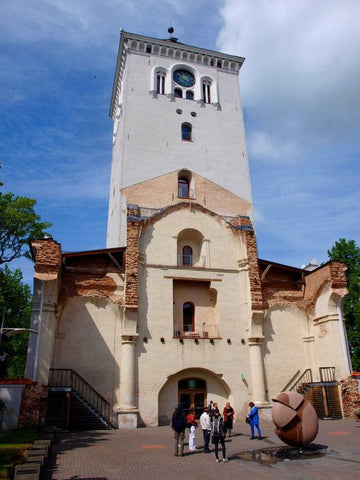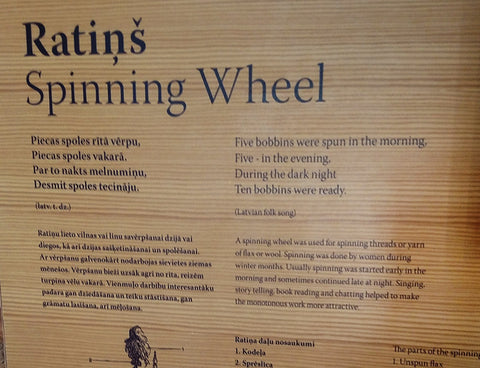Our Baltic Trip 2016, Part 7 - Jelgava & Tervete Posted on 18 Mar 17:38 , 0 comments
We collected our rental car in the morning (a black Volkswagen Passat, same as the one we drove from Tallinn. This particular one had previously belonged to the Latvian Department of Education) and headed out of the city. On the outskirts of Riga, our first stop was a grocery store. We always do “supermarket tourism” wherever we go. Ilga oohed and aahed over the various items she recognized from her childhood. Lunch supplies in hand, we set out for Jelgava.
Ilga’s mother had lived in Jelgava as a girl, so it held special interest for her. It is the fourth largest city in the country (although its population is only about 60,000). It was nearly totally destroyed in the war, so most of the buildings date from the Soviet era. We spent most of our time in the rebuilt steeple of the ruined Trinity Church. It was all that remained of the original massive church.

The reconstructed steeple of Trinity Church. Photo from http://podroze.onet.pl
This housed a fine small museum detailing the history of the area and the local folk costumes and a whole floor dedicated to fiber arts!

Plaques in the fiber arts section of the museum

Plaque in the fiber arts section of the museum
The plaque discussing spinning wheels quotes an old folk song - Five bobbins in the morning and five in the evening... - I have really got to get my spinning act together!!! The top of the steeple featured a glass-walled look-out room, with expansive views of the surrounding country, including the park around the river, and the restored palace of the dukes of Courland, now an agricultural college.
Mike had seen references to local Iron Age hill forts in the museum displays, and wanted to ask the staff in the tourist information office at the base of the steeple about any nearby that could be visited. Unfortunately, the English-speaking staffer had left, so Ilga struggled to explain by trying various direct translations of “fort place” or “defensive place.” Flustered, she couldn’t remember the word for hill or mountain. Little progress was made until Mike recognized the name of one on the map, Tervete. That instantly illuminated what we were asking about. The staff directed us down to Tervete, and we learned the word for hill fort: pilskalns, literally “castle hill”.
After a brief lunch by the river in Jelgava, entertained by begging seagulls, we set off for Tervete. The drive took us through the farmland of Zemgale, considered the bread basket of Latvia. The countryside lived up to its name as extensive fields of grain lined the road in all directions. The village of Tervete itself was more of a speck on the map than anything else, but on the road out of town we found the pilskalns, as well as a forest park, and a partial reconstruction of an Iron Age stockade. We took a walk to an idyllic house and garden in the woods, the preserved home of Anna Brigadere (1861-1933), a beloved Latvian children’s author.

Anna Brigadere's house, in winter. Photo by Igors Jefimovs
Unfortunately, it was raining hard, so we didn’t spend as much time as Mike would have liked. This was really the only day that the rain interfered with our plans in Latvia
Setting out again, we headed for the town of Dobele. The center of town had a nice castle ruin, so we stopped long enough for Mike to take a quick walk around it under threatening skies, while Ilga knitted in the car. A wedding party was trying to dodge the rain as they posed for photos in the castle grounds. Our tourist information told us that Dobele held the Latvian State Institute of Fruit Growing, an extensive garden of fruit trees, based on the work of a renowned local plant breeder, Pēteris Upītis. Unfortunately, the garden was already closed by the time we arrived, as indicated by the Latvia version of a Beware of Dog sign on the gate: Nikns Suns!, or literally, “Angry Dog!”. We try to collect local versions of "Beware of Dog" signs when we travel, especially if they depict German Shepherds, but we unfortunately did not find one of these for sale.

Beware of Dog sign at the Dobele Fruit Growing Institute. The sign translates literally as "Angry Dog!"
The small museum on site was also closed, but some staff was still there. They invited us in to come in and look around. It held a room of artifacts from Mr. Upītis, and a display of botanical paintings by local artists, which had been hung in preparation for the big civic festival planned for the next day. It was a lovely visit and another example of the hospitality of the people we encountered.
Time was running on, so we pushed on to Liepāja, our destination for the night, on the A road (highway), avoiding the temptation of further stops. It was a Friday night, so there was a certain amount of traffic, we assumed people from Riga going to the seaside for the weekend. We let them all pass us so that we could drive at a more leisurely pace and enjoy the countryside.
